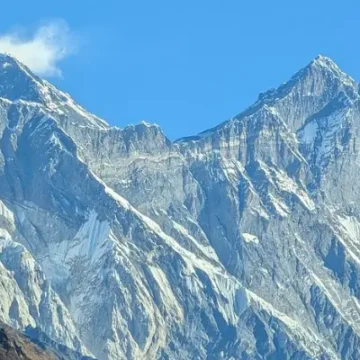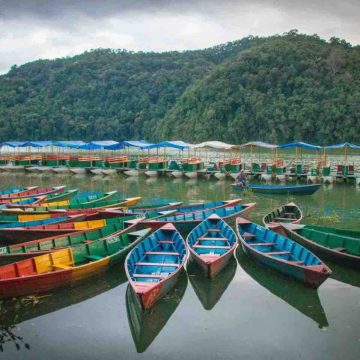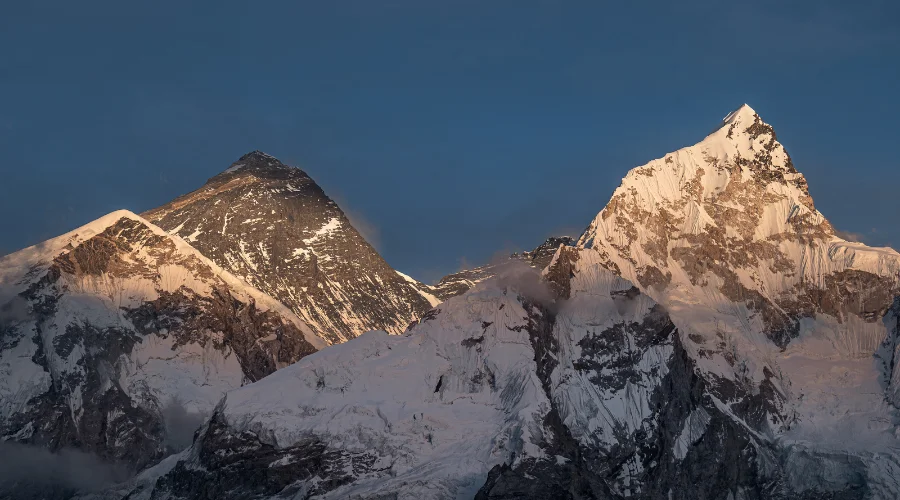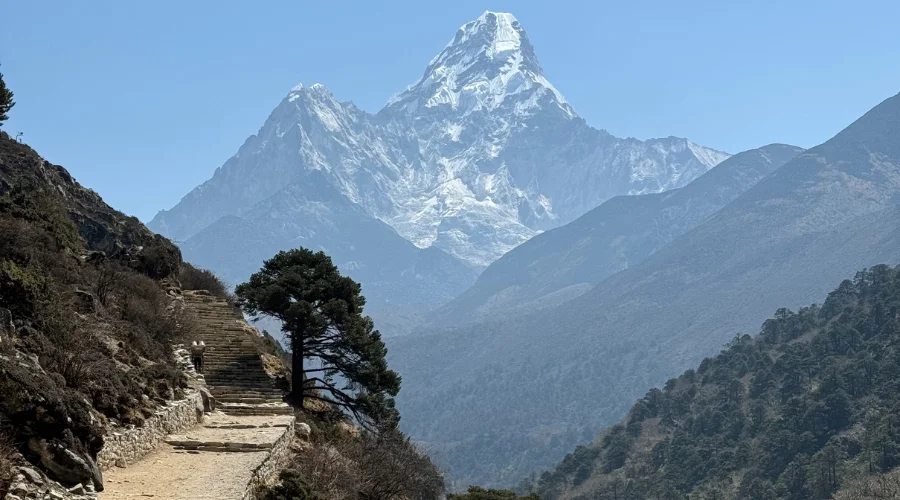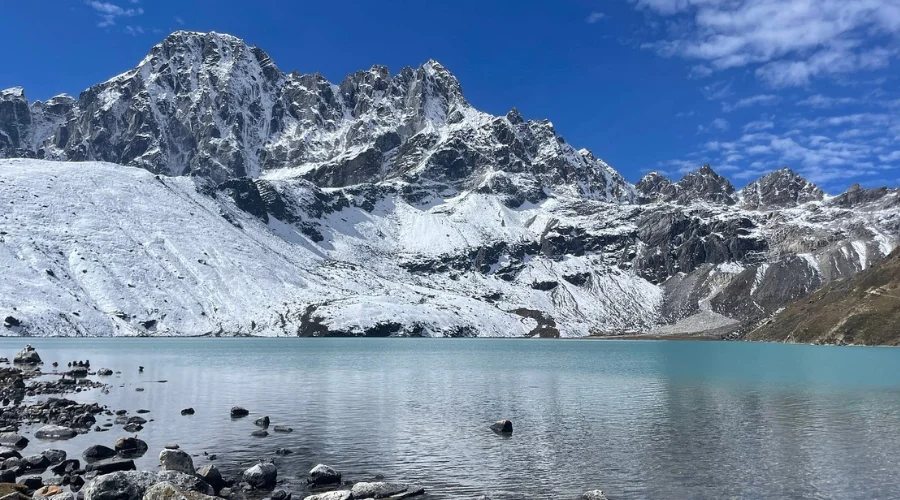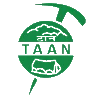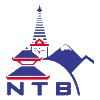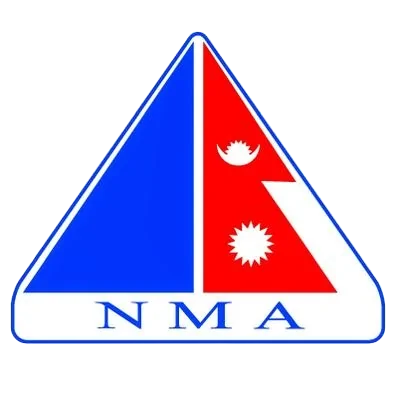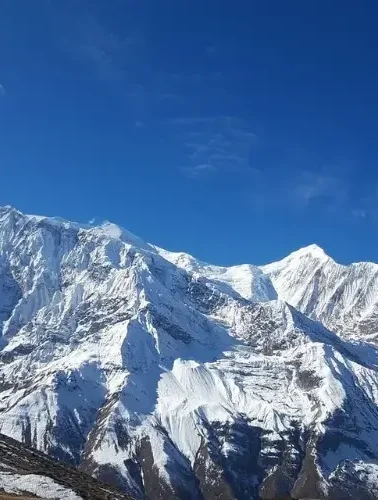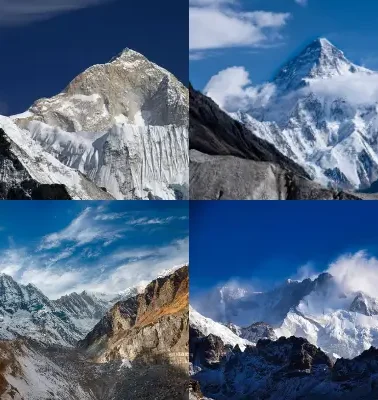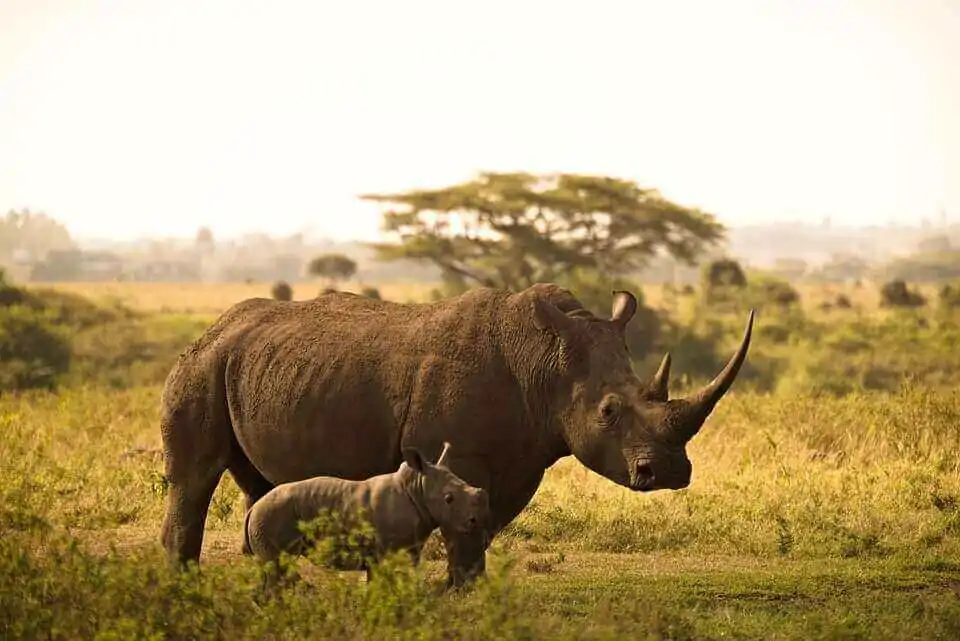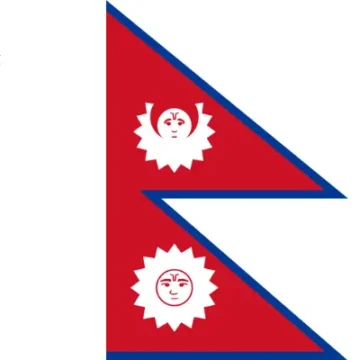
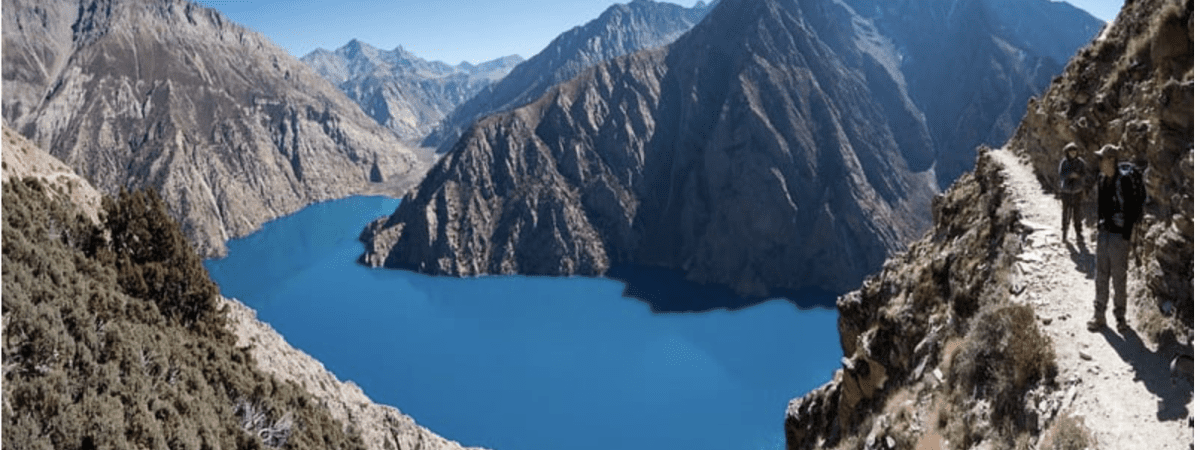
- TRIP DURATION
- 24 Days
- MAX. ALTITUDE
- 5320 m
- TRIP GRADE
- Hard
- LODGING
- Tea House & Camping
- BEST SEASON
- Spring and Autumn
- MEALS
- Breakfast, Lunch & Dinner
- COMMUNICATION
- Wi-Fi/ Local SIM Card
- PER DAY WALK
- 6 to 7 Hours
Upper Dolpo Trek Itinerary- 24 days
Close to the Tibetan Plateau, Dolpo is one of the least explored regions of Nepal. With its boundary far away from modernisation, the intact natural beauty and serenity of the Upper Dolpo Trek are beyond explanation. If you ought to know what natural bliss and peace mean, Dolpo is the only place you ever need to be.
Upper Dolpo Trek remains a restricted region, meaning you need a special permit to wander here. Upper Dolpo trekking was only opened for tourists in 1989 and is protected as part of Shey Phoksundo National Park. Shey Phoksundo Lake is Nepal’s smallest and deepest lake, with colourful blue water.
Along with many natural wonders, Dolpo is also a place where you can witness the pure form of Tibetan culture. In the higher region, you can witness colourful alpine shrubs, and the lower region has an abundance of lush green meadows. You might find the hidden wildlife of blue sheep, mountain musk deer, and snow leopards among these lush meadows.
The Upper Dolpo trek route commences from Juphal when we fly from Nepalgunj. That means we should first get to Nepalgunj via flight or road and then fly to Juphal. Now, passing through many settlements, we shall reach Shey Phoksundo Lake at 3600 meters.
Then, we cross the Kang—La Pass, which is known to connect the Phoksundo Valley and Shey Gompa. Then, we explore the valley of Upper Dolpo, where we will get an absolute retreat with the nature and culture of remote villages.
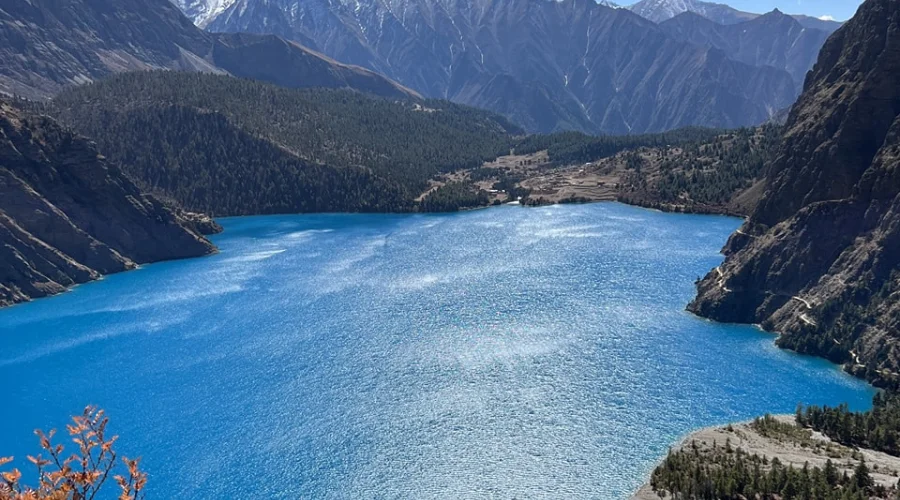
About Dolpo
Dolpo is an isolated, remote district in the far-western region of Nepal, Karnali Province. Geographically, it is the highest and largest district in Nepal. And culturally, it is one of the most ancient Tibetan regions, untouched and undisturbed by the outer world.
Due to its remote location, the region has been a precious land for culture and deeply rooted religion and religious communities.
The region is divided into Lower and Upper Dolpo, each with its own beauty, customs and unique landscapes. Lower Dolpo is a perfect blend of mixed ethnic groups, whereas Upper Dolpo is rich in Tibetan culture.
Dolpo is especially known for its authentic, raw beauty and mystique, often called Nepal’s last spiritual frontier. Likewise, Dolpo has been the inspiration for several filmmakers, local and international, one popular movie being Eric Valli’s Oscar-nominated film “Caravan”.
Where is Dolpo Located?
Dolpo district is a secluded, horseshoe-shaped region in the northwest region of Nepal. It lies north of the Dhaulagiri range and west of Kali Gandaki Valley. The region is situated between the Himalayas and the Tibetan plateau, sharing a border with Tibet.
Due to its position, tucked behind the high Himalayan ranges, the region receives very little rainfall.
Upper Dolpo Circuit Trek traverses around the Dolpo district, which is accessible via air from Kathmandu to Nepalgunj, then to Juphal. Actual trekking in Upper Dolpo only starts from Juphal.
The region lacks road access, making the trekking route and most parts of Dolpo only accessible by walking. Though challenging, completely off-the-beaten-path rugged terrain makes the trek thrilling.
Upper Dolpo Trek Facts
Trek Duration: 24 days
Total Trek Distance: Approximately 260-280 km (161-174 miles)
Max Elevation: 5320 meters (17,454 ft) at Kang La Pass
Starting/Ending Point: Kathmandu (1400 m/4593 ft)
Trek Starting/Ending Point: Juphal (2503 m/8212 ft)
Difficulty: Hard
Accommodation: Teahouse, camping
Transportation: Flight/Jeep
Best Season: Spring and Autumn
Upper Dolpo Trek Permit: Restricted Area Permit (RAP), Shey Phoksundo National Park Permit
Upper Dolpo Trek Highlights
- Follow the footprints of the traditional trans-Himalayan traders during the Upper Dolpo Trek and enter the wilderness of mountains.
- Explore the unique semi-arid vegetation behind the majestic Dhaulagiri range.
- A camping trek experience for the sense of true wilderness.
- Witness century-old Bon practices in various monasteries (Shey Gompa, Yangze Gompa, and Bon Gompa) and live a classic Buddhist tradition.
- Enticing views of Yak Caravan and lakes such as Shey Phoksundo.
- Almost a month-long trek in Nepal’s mountains on a trail explored by few- a genuinely fulfilling and rejuvenating experience.
- Explore the local lifestyle of people living in villages like Dho Tarap and Saldang.
- Cross several high mountain passes like Kang La and Jeng La (5110 m/16,765 ft).
- Spotting herds of yaks and Chyangra (mountain goat used for Pashmina wool) grazing, snow leopards, blue sheep, and other rare flora and fauna.
- Visit the world’s highest human settlement village – Dho Tarap.
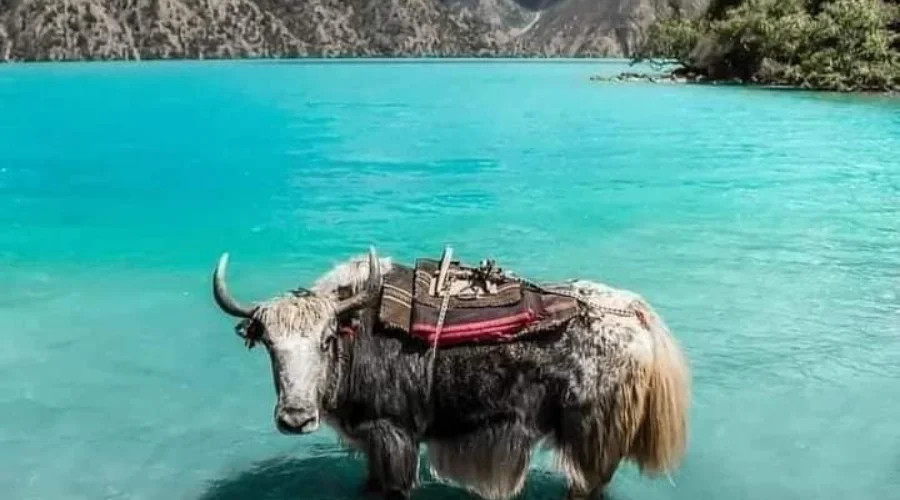
Dolpo Trekking Nepal Experience
Upper Dolpo trekking is a very uncommon adventure that gives one the possibility to peek into the undiscovered and off-road world, which is never going to be forgotten.
The Upper Dolpo Trek itinerary, which lasts 24 days, takes you to the top of rugged mountains, deep valleys, and high mountains. This experience makes you feel that you are the only person on Earth, so the views never end.
The region has a wealth of culture and seems to be overwhelmed with tradition.
There is no doubt that one of the biggest highlights of the Upper Dolpo trek is visiting Shey Gompa, one of the oldest monasteries in the world. The Monastery is located in one of the most picturesque places and is completely immersed in beautiful mountain peaks and pure scenery.
Another interesting part of the hike is the cultural encounter, where the locals openly share their customs, hospitality, and Upper Dolpo culture in their heritage.
The hiking route crosses several riverside hamlets; the buildings are far from the narrow road. Houses made of mud bricks with Tibetan prayer flags are prominent in the landscape.
The area is rather distant from the cities, with no facilities or infrastructure. Therefore, when trekking, you are expected to be equipped to hike for a long time and be ready for camping and non-luxurious accommodations.
Although the remote location is worrisome, the breathtaking views, wild culture, and sense of adventure get one’s heart pumping.
Dolpo Trek Map
Starting the Upper Dolpo trekking map with an exciting flight from Kathmandu to Nepalgunj. Then, fly to Juphal and start trekking. The trek traverses through several remote villages, and finally, after around 2 weeks, the trek comes to an end at Juphal again. Finally, fly back to Nepalgunj and Kathmandu.
Note: It is always better to carry an Upper Dolpo trek map with you.
Important Notes for Dolpo Trek Nepal
- As the flights to Juphal are often delayed or cancelled due to bad weather, we recommend you have extra days on your Nepal Visa.
- This is a mix of a teahouse and a camping trek. Around the Lower Dolpo region, trekkers can stay in teahouses, but in the Upper regions of the trek, there are no teahouses. So, you are going to have a camping trek experience.
- This is a restricted area, so trekkers are required to obtain RAP and must be a group of at least two people and a licensed guide.
- The trek traverses through some of the highest mountain passes and villages. So, it is essential to acclimate properly.
- We strongly advise that you have travel insurance that covers high-altitude trekking and helicopter evacuation. Since there are no roads, helicopter evacuation is the only way during emergency cases.
- Your guide and porters are your only friends in the mountains. Listen to their instruction at all times.
- There are no ATM services, so carry Nepali currency cash.
- It is remote trekking, so packing some snacks for the trail is wise.
- Lower and Upper Dolpo Trek is a long trek. So, try trekking as lightly as possible.
Benefits of Booking the Dolpo Trekking With Himalayan Masters
Himalayan Masters is the best trekking company in Nepal. If you are trekking with us, we offer the best services and the most well-managed Upper Dolpo trek itinerary.
Here are some of the benefits of booking Dolpo trekking with Himalayan Masters.
- Free airport pickup and drop-off.
- Experienced and licensed guide and porter for the trek, including the trek package.
- All meals, accommodation, transportation, and permits for the trek are included in the trek package.
- -25° rated sleeping bag and down jacket as a complimentary service for the trek.
- Himalayan Masters branded t-shirt, cap and water bottle as souvenirs.
- Water purification tablets, trekking poles, crampons, etc., are provided by the company for the trek.
- Trek completion certificate.
- East trek customisation, postpone, prepone, and cancellation.
- 24/7 technical support.
A typical day on the Upper Dolpo Trek
A usual day on the Upper Dolpo Trek starts with a morning waking up when the sun rises over the beautiful Himalayan scenery. A delicious breakfast is served at the teahouse.
Trekkers start their trek, going through a tough trail and crossing high-altitude mountain passes. They will be enjoying the view of several white snowy peaks. On their journey, they pass by isolated villages, old monasteries, and the unique Tibetan culture to better understand the rich local culture.
Our lunch break is along the trail at a teahouse or a scenic spot. By lunch, trekkers ascend, marvelling at the pristine scenery of the untouched wilderness and encountering wildlife species like yaks and mountain goats.
At the end of the day, trekkers will be doing their last leg to their chosen destination, where they will enjoy a warm dinner and socialise with other trekkers before heading to the cozy accommodation for a much-needed rest.
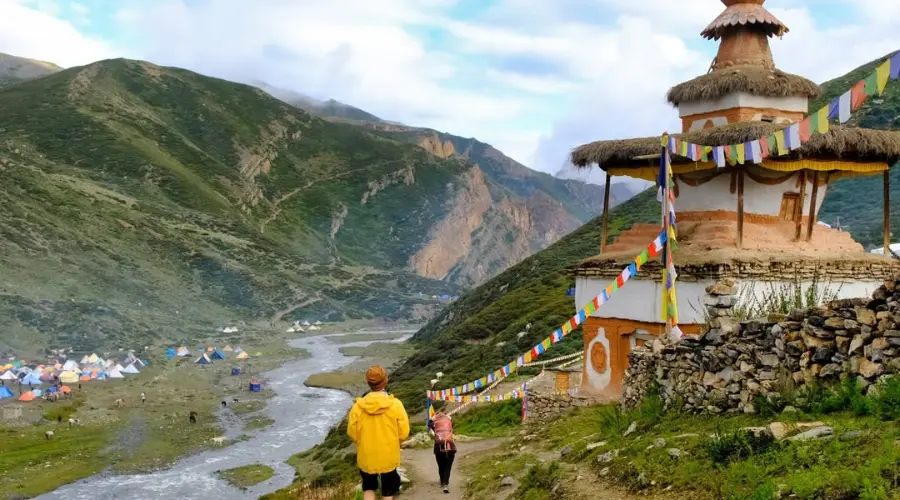
ITINERARY
Day 01: Fly from Kathmandu to Nepalgunj
Our exciting journey to the Upper Dolpo begins only after we fly to Nepalgunj from Kathmandu (1400 m/4593 ft). Nepalgunj is a beautiful city on the southern border of India. Indians can directly join our Upper Dolpo Trek at Nepalgunj (150 m/492 ft).
Since the flight from the domestic terminal of TIA is usually scheduled in the morning, we shall have an entire day to explore Nepalgunj.
Do visit the local temples and ponds while you try the street foods of Nepalgunj.
Overnight stay in a hotel.
Day 02: Fly from Nepalgunj to Juphal and trek to Dunai
Our second flight from Nepalgunj takes us to Juphal (2503 m/8212 ft). We fly as early as possible since the weather in the mountains can be very unstable. With awesome views of lush hills and the beautiful Himalayas, the mountain flight to Juphal definitely feels exciting.
At Juphal, we get our bags ready and start heading along the Thuli Bheri River on a gentle downhill route.
Soon, we will be walking on a narrow ridge through terraced fields, taking us to Dunai. Dunai (2140 m/7021 ft) is the largest settlement of Dolpa and also its headquarters.
Overnight stay in a tented camp.
Day 03: Trek from Dunai to Ankhe
On the 3rd day of the Upper Dolpo Trek Itinerary, we follow the Bheri River to the north. The suspension bridge and terrace farms along the trail keep us excited while we walk to Phoksundo River Valley.
Hiking over more ridges and canyons, we get to Rahagaon, where we can see some quite old houses. Then, we walk into the very dense forest into a village that is called Ankhe (2896 m/9501 ft). It’s a perfect place to immerse yourself in nature, surrounded by forests and chirping birds.
This is where the Shey-Phoksundo National Park commences, and the mountains become clear.
Overnight stay in a tented camp.
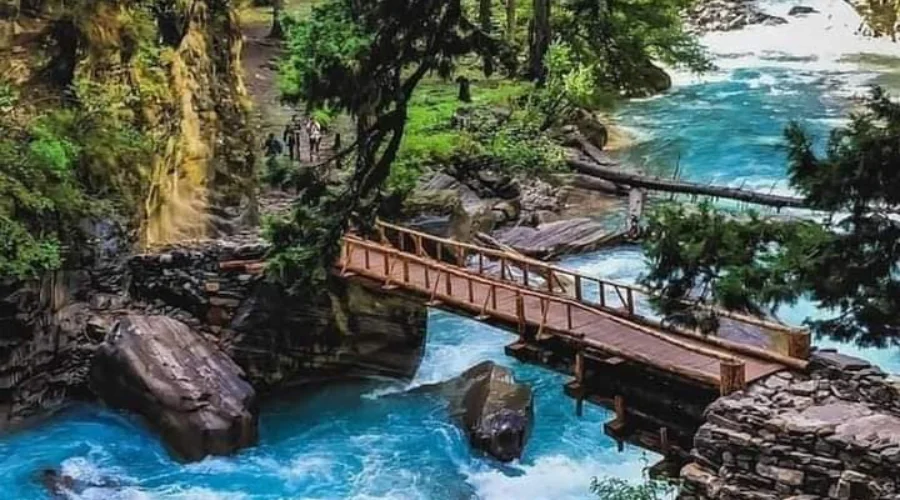
Day 04: Trek from Ankhe to Sulighat
Today’s trial is a little challenging but rewarding. We continue the Dolpo trekking package by walking in the sub-tropical forest, making many ascents, and descending on the way. There are some steep ridges and several drops into deep gorges on the route.
Walking via the river that flows on a very rocky path, we reach Ryajik, all along the aromatic smell of cedar and juniper trees.
After some interaction with the local area, we move towards Sulighat (2282 m/7487 ft). Sulighat is a small, peaceful riverside village located at the junction of the Phoksundo and Suli rivers.
We stay in a tented camp in Sulighat.
Day 05: Trek from Sulighat to Phoksundo Lake
The 5th day of our Upper Dolpo trek is actually going to be exciting as we stroll in the valley leading us to the Phoksundo River and Pungmo River junction.
It is a highlight day of our trek as we will be reaching one of Nepal’s most magical destinations, Phoksundo Lake (3600 m/11,811 ft). Especially the last part of today’s trek offers a one-of-a-kind view as you will be able to witness the deep turquoise lake beneath towering cliffs.
Phoksundo Lake is a revered lake by Buddhist and Bon practitioners. The lake is decorated with prayer flags and a few small monasteries around its periphery.
Today, we will be camping near the lake, under the open sky, with stars and peaks reflected on the water. This is going to be nothing like any night you have experienced before- silent, surreal, and spiritually moving.
Day 06: Explore Phoksundo Lake
As we are already at 3,600 meters above sea level, it’s wise to stop for a day and let our bodies rest well in this Dolpo trekking package. And the pristine beauty of Shey Phoksundo Lake makes it a perfect spot for acclimatisation and learning the local Dolpo lifestyle.
The prodigious turquoise-coloured lake and the visit to the Ringmo village make your day fruitful. We shall also visit Tshowa Gompa, a 900 years old Tibetan Buddhist Monastery nearby.
After we have visited around, we will be returning to our camp.
Day 07: Trek from Phoksundo Lake to Phoksundo Khola
After a wonderful day on the Lakeshore, we move to the north of Phoksundo Lake. Hiking in the tough rocky hills and the lush grassland, we get to the Phoksundo Khola (3570 m/11,713 ft). It is a small, remote area with minimal human settlement.
This part of the route could be a little tricky as the trail is unmarked and, at times, requires careful steps.
Today, we will be camping at the bank of Phoksundo Khola and maybe doing some fishing if possible.
Day 08: Trek to Phoksundo Bhanjyang
Now, we walk on the north side of the river, entering the glacial valley. Crossing many bridges in the river junction and yak pastures, we continue the uphill climb to a steep gorge.
From the hilltop, we can see the Kang-La Pass, which connects us to the Dolpo Valley. The elevation gain today is significant, so it is necessary to walk steadily and at a slow pace.
For today, we set our camps right at the Phoksundo Bhanjyang (4,717m/15,417ft), just below Kang La Pass. It is for preparing for the next day’s high-altitude crossing.
Day 09: Trek from Phoksundo Bhanjyang to Shey Gompa Dolpo
Ready for the most difficult and exciting part of your Upper Dolpo trek? Today, we walk beyond the Phoksundo valley and get to the Dolpo region.
For that, we need to cross the via Kang-La pass, which lies at 5360 m (17,585 ft) above sea level. This is the highest point of our trek, offering the most magical view of deserted valleys and Crystal Mountain Valley.
Now, heading downwards, we cross some more streams and yak/sheep meadows to get into a red Buddhist shrine. Here, we are welcomed into Shey Gompa Dolpo (4500 m/14,764 ft). It’s your first night in the Dolpo region.
There are a few teahouses here where we can spend the night.

Day 10: Rest Day at Shey Gompa Dolpo
As the team will all be tired from the walk to the Kang-La Pass, you all deserve a rest day at Upper Dolpo Trekking. And without a doubt, Shey Gompa is an exciting place for rest and acclimatisation while we explore Dolpo.
During the daytime, we take our time to explore Shey Gompa Dolpo. This is an important monastery in Upper Dolpo Trekking with hundreds of Buddhist devotees.
It is believed that every 12 years, the monastery acts as the spiritual axis. During this year, devotees from around the region gather here for the Shey festival.

Day 11: Trek from Shey Gompa Dolpo to Namduna Gaun
After a rest day, we are all rejuvenated to walk on the path amid the Juniper Forest to explore Dolpo. Walking through the rocky canyon, we walk via the meandering trail, first getting to Saldang-La Pass.
At 5,200 meters, this will also be a challenging climb, but the views from the top are worth it. Then, we descend while walking north to Namduna Gaun (4430 m/14,534 ft).
After visiting the Namgung monastery, we crash in one of the teahouses at Namduna Gaun for the night of this Dolpo trekking package.
Here, you can see herders grazing Chyangra, Himalayan goats raised for pashmina wool. The village is especially known for its Red Monastery, which is a spiritual centre.
Day 12: Trek from Namduna Gaun to Saldang
We start the 12th day of Upper Dolpo Trekking by walking in the barren hills for a couple of hours. Today’s walk to the Saldang Village (3770 m/12,369 ft), which lies on the slope above the Namgung River, will be quite easy and relaxing.
This is the biggest village in Inner Dolpo, and it has almost 600 people. The village is still an active part of the old salt trade route with Tibet.
You will find some decent teahouses and terrace farms during this exploration of Dolpo.
Day 13: Trek from Saldang to Yangze Gompa (4960 m/16,273 ft)
Although our stay in Saldang village will be quite fun, we will leave the place to head further north. Walking to the Nang Chu, we enter the more remote villages of Tiling and Lurigaon.
Today’s destination is Yangze Gompa (4960 m/16,273 ft). This is a less-visited and lesser-known hidden monastery that few tourists reach. Trekkers can explore this beautiful monastery with murals and sacred texts dating back centuries.
It’s a challenging yet exciting hiking route leading further into the remote Dolpo region. The path to the monastery follows the steep and rugged terrains of Dolpo. We can also see the Bon-Po monastery, visit the Panzang River, and stay in one of the teahouses.
Day 14: Trek from Yangze Gompa to Sibu
From Yangze, our Upper Dolpo Trekking Itinerary is two paths leading us to Sibu (4000 m/13,123 ft). If you pick the longer route, we get to walk via the villages of Nisalgaon and Shimengaon.
However, we walk on a shorter path that first takes us to Saldang village and then turns towards Namdo village. This is also a large valley with almost 400 residents.
In the daytime, we get to pray at Namdo monastery, which lies close to the Nam Khong River, and then walk for a few more hours to Sibu.
On the route, you might be able to see blue sheep, marmots, and even the snow leopard.
Day 15: Trek from Sibu to Jeng-la Phedi
Now, following the Nam Khong River, we walk into the yaks’ caravans. In summer and spring, you can see many yak herds grazing around in these caravans. However, the winter is all covered in snow.
In a few hours, we will get up to the Jeng La Phedi (4900 m/16,072 ft). It is not a village but just temporary herder shelters. So, we camp at the foot of the pass and prepare for the next day’s challenging Jeng La Pass crossing.
Day 16: Trek from Jeng-la Phedi to Tokyu Gaon
The starting of the day is going to be quite challenging as we get to the top point of Jeng La Pass at 5110 meters (16,765 ft). So, we start trekking early. These two hours of the hike are worth the awesome, picturesque views of the Dhaulagiri massif.
Now, we walk down to Tarap Valley and then to Tokyu village (4209 m/13,809 ft), which is our stop for the night. Tokyu village is one of the highest permanent settlements in the world.
Day 17: Trek from Tokyu Gaon to Dho Tarap
Today’s walk is quite relaxing as we head into the broad, fertile valley of Dho Tarap (3944 m/12,940 ft). In the daytime, we visit several Chortens and take many beautiful pictures before crashing at Dho Tarap.
Dho Tarap is an important destination for Upper Dolpo Trekking. The village has over a dozen monasteries and is known for its Bon religion.
Stone houses, fluttering prayer flags, prayer hymns, and a peaceful environment set this village apart.
Day 18: Acclimatization day at Dho Tarap
Today’s rest is not only for acclimatisation. Since we want our trekkers to understand the lifestyle and culture of Dolpo, we spend a beautiful day here.
Dho Tarap is a huge settlement at the highest altitude one can possibly imagine. Here, we get to visit the villages and the beautiful gompas. You can build friendships with some of these Magars and Tibetans while visiting Bon Gompa. This is the highlight of the Inner Dolpo trek.
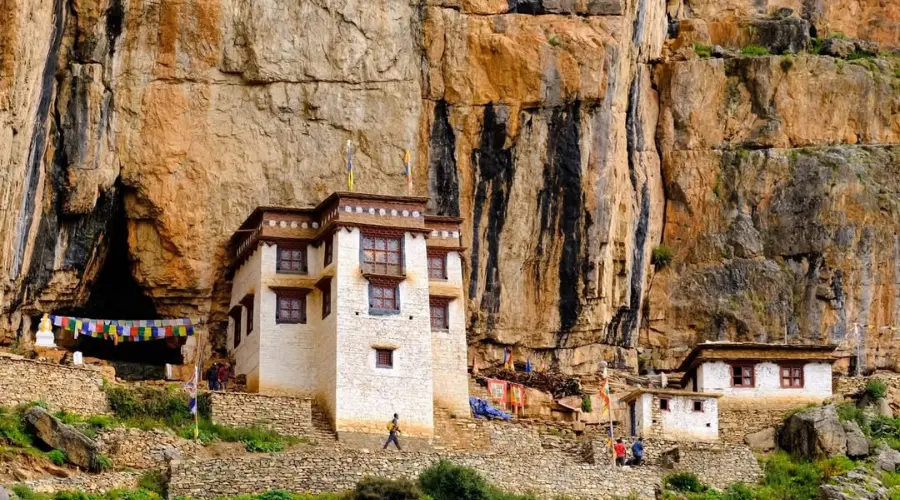
Day 19: Trek from Dho Tarap to Tarap Khola
Now, we start to lose altitude while we continue to descend to the lower section of the valley. Today’s trek through the bushes of junipers brings us to the meeting point of Tarap Chu and the Lang Khola.
Then, we walk to Tarap Khola (3800 m/12,467 ft), which is also called Khoma Kharka, to set up our camps. Camping beside the river gives you a chance to explore yourself while you immerse yourself in the melody of flowing water.
Day 20: Trek from Tarap Khola to Khanigaun
Another day of an easy walk in the gorge of Tarap Khola until we reach Khanigaun (2950 m/9679 ft). It is one of the remotest and secluded regions in the Dolpo trek. We will rarely see any houses or even meet any people in this section of the tour.
Here, in a small riverside village, we will set up our camp, relax, and reminisce about the challenges and our triumphs of this trip.
Day 21: Trek from Khanigaun to Tarakot
First, we walk to the Lalberi village (Laina/Lahini Odar) and then cross the thick sub-tropical forest leading us to the river.
Then, we get to the Tarakot (2537 m/8324 ft), a small town in Dolpo that was one of the fortresses. Tarakot was earlier the centre of the Tichorung Kingdom and used to be the hub for international trade in the past. This is one of the last remote villages in the Dolpo region before heading towards Dunai.
Today, we camp for the last time in one of the best camping treks in Nepal.
Day 22: Trek from Tarakot to Dunai
After morning breakfast, we first get to the Bheri River. Now, walking via many gorges, we get to Lawan village. Exploring some more settlements of Byasgar and Lochakhola Gaon, our path finally leads us to Dunai (2140 m/7021 ft). The headquarters of Dolpo already has over 2700 residents and great teahouses.
Today’s overnight stay is going to be in a comfortable teahouse.
Day 23: Trek from Dunai to Juphal
It’s an easy walk towards the Juphal airport. After a lavish breakfast in Dunai, we continue walking on the path of Thuli Bheri.
First, we get to Dhupichaur and stop at Rupgad. After a final stop at Motipur, we reach Juphal (2503 m/8212 ft) for the night’s stay. The most memorable trek of your life, i.e. Inner Dolpo, ends here at Juphal; it’s time for celebration.
This is the last day in the mountains. In the evening, we can sit around for tea, coffee, or a glass of locally brewed chhyang and discuss our trip.
Day 24: Fly from Juphal to Nepalgunj and Fly to Kathmandu from Nepalgunj
Now it’s time to say goodbye to stunning trekking in the Dolpo region.
Early in the morning, we shall first fly to Nepalgunj from Juphal. This short mountain flight with an awesome view of the hills and mountains will obviously be amazing.
Then, we get on a flight taking us to Kathmandu from Nepalgunj. As we reach Kathmandu in midday, we have time for some shopping or go to a relaxing spa and enjoy a great dinner in Thamel. Your Upper Dolpo trek ends here.
You can stay in any of the hotels in Kathmandu, which have all the necessary facilities.
useful info
Best Season to Do Trekking Dolpo
When choosing the best time for Upper Dolpo trek, you need to be careful. Spring and autumn are the best seasons to explore the beauty of this region.
From spring (March to May), this season offers stable weather and blooming vegetation and, as a result, becomes a visually attractive period to hike through in early spring. The temperatures remain moderate most of the time, and the skies are normally clear, dotted with the imposing peaks of the mountain range.
The roads are also not crowded, like during the spring season. Trekkers often might be caught unaware of the occasional rains, which are common, especially in the low areas.
The autumn months of September, October, and November are another prime period for the Dolpo treks. This season’s weather is uniform; it is not very hot in the daytime, and there are no clouds in the sky.
Those autumn months are the optimum time for the best mountain views when the skies are often very clear. This time of the year is also known for its dry trails; thus, hiking becomes quite easy and more convenient.
Adding on, autumn also hosts harvest celebrations here, providing the trekkers a platform to get in touch with the culture and customs of the land.
Weather/Temperature of Dolpo
Upper Dolpo weather changes a lot depending on the season. In spring, the area has slightly warmer temperatures, with daytime highs ranging from 10°C to 20°C at the base, while nights can be quite cold, around -10°C at the summit.
The skies are often uncloudy, resulting in astonishing views and great visibility of the surrounding tops. Spring is also the season when the landscape bursts into its own with wildflowers presenting themselves.
The weather of Upper Dolpo is gentle in fall (September to November), and the sky is clear. Therefore, this period is very convenient for trekking.
Temperatures during the day range from 10°C to 18°C, and nighttime temperatures fall from about -5°C to -15°C at higher altitudes.
The dry autumn weather makes trekking a safer and more comfortable outdoor activity. While the weather is variable, it is especially unpredictable at high altitudes; therefore, trekkers should carry suitable clothing to avoid freezing and getting wet.
Difficulty/Altitude Sickness of Dolpo Trek
The Upper Dolpo trek difficulty is one of the toughest and best treks in all of Nepal. It is a high-altitude trek where we can witness the old Tibetan culture and panoramic views of the mountains.
The Upper Dolpo Trek stands out for its isolated and rugged environment. This makes hikers need to be ready for difficult hike paths, high altitudes, and long walking hours.
A journey in the remote regions of Dolpo includes passing very hard passes like Kang La, Sela La, and Jeng La, which are all over 16,000 feet high and may be physically challenging, adding to the risk of altitude sickness.
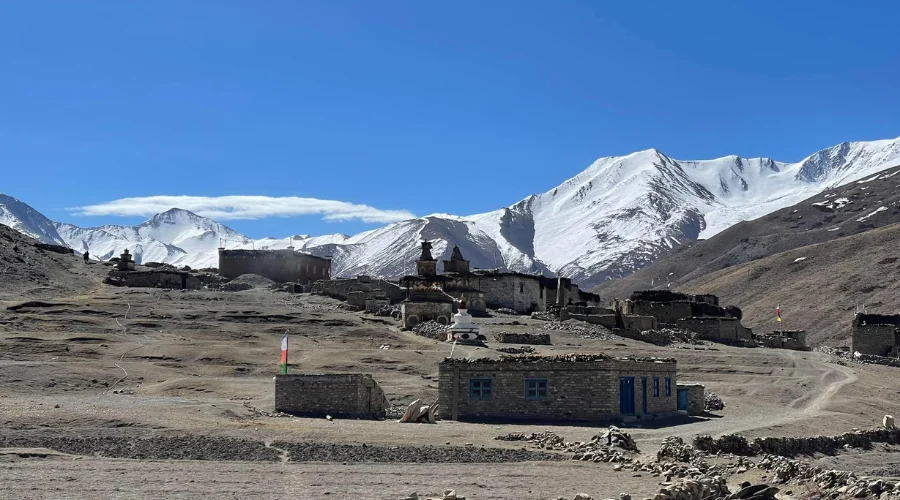
The trail is generally steep, rocky, and perched on a mountain, with minimal facilities and basic accommodation, so hikers should only carry necessary supplies and be self-sufficient.
Navigation is always challenging because the weather can change in a move. Sudden storms, wind, and cold weather are added extremes that will make an Upper Dolpo Nepal trek a challenging task.
Regardless of these difficulties, however, the trip yields magnificent views, ancient monasteries, pure Upper Dolpo culture, the spirit of adventure, and a recognition of the choice as being a true getaway from civilization. These are somewhat the reasons for choosing the trials for those who seek wilderness.
Altitude Sickness at Upper Dolpo Trek
The trekking in Upper Dolpo, Nepal, leads hikers into one of the most elevated and remote areas, which peaks at over 5,000 meters. This journey involves beating the high passes of Kang La, Sela La, and Jeng La, each of which requires a hardcore ascent.
At these heights, the air and oxygen concentration are thinner, which explains a physically exhausting hike. High-altitude trekkers should be well prepared for the hardships presented in such an environment, such as the freezing temperatures and the chances of strong wind storms.
Despite these hardships, the magical mountains, traditional Tibetan life, adventure, and immersion in the wild make the upper parts of Upper Dolpo Nepal a special experience for those who dare to visit.
Our goal is to take the time to properly acclimatize, and our strategy will be to maintain a constant, steady pace throughout the Upper Dolpo Nepal trek.
Trip Grade: Fitness level, Medical, and Health
The Upper Dolpo Nepal is graded as a very demanding trek, suggesting a high level of physical fitness for this hike. Hikers must be healthy, fit, and have experience in a field that requires long walking hours on a difficult day.
The preparations should include training the heart, developing strength, and boosting endurance to shine in the rugged weather.
Likewise, the Upper Dolpo circuit trek involves not only high-altitude passes more than 5,000 meters above sea level but also many steep climbs and descents. In addition, it includes mud, snow, and rocky sections, making it necessary to cross the river several times.
Medical and Health considerations are critical for the Upper Dolpo circuit trek. Due to the high altitudes, trekkers must be aware of the symptoms of altitude sickness and take proper precautions, such as acclimatizing properly and staying hydrated.
It is recommended to have a thorough medical check-up before starting the trek, and those with pre-existing conditions should consult with their doctor.
Emergency and Evacuation at Dolpo Trek
Due to the region’s remote and rugged terrain, emergency and evacuation procedures in the Upper Dolpo trek are challenging.
In a medical emergency, the first step is to contact your guide or local authority, who can arrange for assistance. If the situation is severe and immediate evacuation is necessary, a helicopter rescue is often the most viable option.
However, helicopter rescues can be delayed due to weather conditions and lack of aircraft availability. This makes it essential for trekkers to carry comprehensive travel insurance that covers high-altitude trekking and helicopter evacuation.
Special training for Dolpo Hike
No special training is required for the Upper Dolpo trek, but it is always better to be prepared for the trek with the necessary exercises and training. The Upper Dolpo Trek itinerary lasts around a month with Himalayan Masters. Do some cardio to boost your stamina since you need to walk a lot during the Upper Dolpo trek in Nepal.
Trekking Dolpo Roads/Route
The trekking route through upper Dolpo is well-known for its remote and rough topography. Also, the fact that roads are generally not common in this area.
Meanwhile, some sections of the trek can happen at the same time, along with jeep tracks and trails that the local people use.
So as not to be on these roads and to make sure the trekking experience remains true. Trekkers can opt for different routes or trails that lead away from the roads. Make sure to carry the Upper Dolpo trek map.
Dolpo Trekking Permits
To go trekking in Upper Dolpo, it is mandatory to have permits as it is remote and inaccessible. Trekkers have to take permits for Dolpo Buddha Village Administration, which facilitates all of the wards 4 to 6; Shey Phoksundo Rural Municipality encompasses all of the wards 1 to 7, and Charka Tangsong Rural Municipality covers all of the wards 1 to 6.
The total Upper Dolpo permit cost is $500 for the first 10 days. If the Upper Dolpo Trek itinerary lasts more than ten days, an additional Upper Dolpo permit cost of $50 per person per day is payable.
Likewise, you will need a Lower Dolpo restricted permit, which costs USD 20/per person for the first seven days. An additional $5 per day is needed for the more extended stay. This permit is needed inside Thulibheri Municipality and Shey Phoksundo Rural Municipality.
Additionally, as the trek traverses around Shey Phoksundo National Park, so you will need a national park entry permit. It costs $30 per person per entry.
These travel permits also manage and conserve the area. Hence, the natural and cultural environment of Upper Dolpo is secured to appreciate the beauty and heritage of this unique region.
The trekkers should, in advance, arrange for these permits through a registered trekking agency, as this is usually an essential requirement for an unproblematic visit to this world-class region of Nepal.
Dolpo Trek Nepal Cost
The Upper Dolpo Trek cost fluctuates with the season and Upper Dolpo Trek itinerary you plan to spend on your trek. However, the overall Upper Dolpo Trek cost is usually $4200. Upper Dolpo Trek cost per day depends on how you spend during the trek.
The Upper Dolpo Trek cost fluctuates with the season and Upper Dolpo Trek itinerary you plan to spend on your trek. However, the Upper Dolpo Trek cost is usually $4200. Upper Dolpo Trek cost per day depends on how you spend during the trek.
The Upper Dolpo permit cost might be crucial. They are $500 for the first 10 days and $50 per person per day after that.
It is recommended that you hire a guide for $25 – $35 per day and a porter for $20 – $30 per day, including all meals, accommodation, and insurance.
Staying at a teahouse costs around $10 to $20 per night, including meals. Meals cost between $5 and $10.
Airfares from Kathmandu to Juphal range from $200 to 300 per person, and bus rides are more affordable.
The price of renting or buying equipment ranges from $1 to $10 per item per day. You must also plan for items such as travel insurance, tips, souvenirs, and other activities.
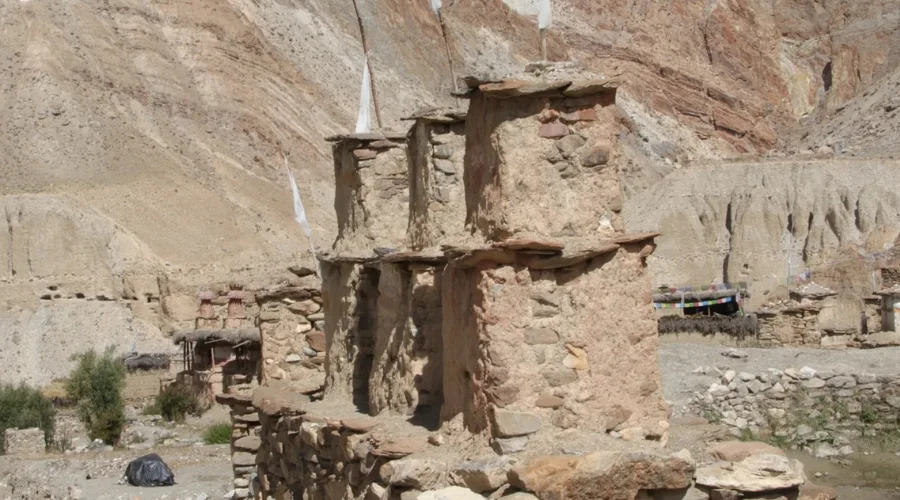
Travel insurance for Upper Dolpo Trek
It is mandatory for trekking in Upper Dolpo to have high-altitude trekking travel insurance. Make sure the insurance covers medical evacuation and cancellation for unexpected natural disasters.
The trek is extremely difficult and remote. Therefore, travel insurance with a range for high-altitude trekking and helicopter evacuation provided is a necessity. It eases the mind, and trekkers will be able to get relevant medical care and assistance in case of an emergency.
Additional expenses for Upper Dolpo Trekking
Besides the Upper Dolpo Trek cost of trekking, travel insurance, and other expenses, hikers should also budget for equipment rental or purchase, bits of gifts, gratuity to the guides and porters, and any optional activities and side trips.
The rental fees might include activities such as the use of sleeping bags, trekking poles, and down jackets, which are available in Kathmandu or Juphal before starting the trek. However, if you are trekking with Himalayan Masters, we provide some of these trekking gears for the trek as a complimentary service.
Moreover, a ticket from Kathmandu to Nepalgunj is another factor that will increase additional Upper Dolpo Trek costs.
Although expenses will likely vary based on specific desires and situations, budgeting rightly is crucial to have a pleasant and memorable trekking experience in Upper Dolpo).
ATMs on Upper Dolpo Trek
While we cannot expect an ATM to be in such a remote area, you can find one in major cities like Kathmandu and Nepalgunj. It is always better to carry enough Nepali currency cash before going on the trek.
Some places on the Upper Dolpo Trek also have ATMs, like in Juphal, but you cannot use the ATM because of the internet access in the area. Since it is a remote area, the internet may not work as per your needs.
Packing List
Some of the essential kit and equipment for Upper Dolpo Trek are:
Clothing
- Base layers (thermal tops and bottoms)
- Insulating layers (fleece or down jacket)
- Waterproof and windproof jacket and pants
- Trekking pants and shirts
- Warm hat and gloves
- Sun hat and sunglasses
- Buff or neck gaiter
- Lightweight trekking shoes
- High-quality trekking boots with ankle support
- Gaiters for snow and mud protection
- Socks (wool or synthetic, multiple pairs)
Camping Equipment (if you want one)
- Tent (lightweight and durable for high-altitude conditions)
- Sleeping bag (rated for sub-zero temperatures)
- Sleeping pad or inflatable mattress
- Portable water filters or purification tablets
- Lightweight water bottles
- Headlamp with extra batteries
Trekking Gear
- Trekking poles
- Backpack (50-70 litres)
- Daypack (20-30 liters)
- Waterproof backpack cover
- Map and compass or GPS device
- Multi-tool or knife
- Lightweight binoculars (optional)
- Trekking umbrella (optional)
Personal Items
- Personal hygiene items (toothbrush, toothpaste, biodegradable soap, wet wipes)
- Sunscreen and lip balm with high SPF
- First aid kit (bandages, antiseptic wipes, pain relievers, blister treatment)
- Personal medications
- Quick-dry towel
- Travel documents (passport, permits, insurance)
Food and Snacks
- High-energy snacks (nuts, energy bars, dried fruits)
- Lightweight, easy-to-cook meals (instant noodles, dehydrated meals)
- Electrolyte tablets or powder
Miscellaneous
- Camera with extra batteries and memory cards
- Solar charger or power bank
- Trash bags for waste
Accommodation and Food During the Upper Dolpo Trek
The traditional lifestyle of Upper Dolpo shows unique ancient Tibetan customs and religious practices associated with the native Bonpos religion. On the route are teahouses, lodges and camping that provide two-person accommodations in twin beds or dormitory rooms.
Teahouses offer a haven full of hospitality after a long day of covering the same distance. The rooms have blankets, but trekkers are recommended to carry their sleeping bags for more warmth, preferably during the colder periods.
Whereas, as you trek to higher elevations, there are no teahouses. So, the only means of accommodation is camping. You will have to carry all the camping gear, along with cooking utensils and food.
Though challenging, this camping trek offers a unique way of exploring the Dolpo region. It offers more immersive experience, where you can interact with locals, and maybe sometimes dine with them.
Regarding the food in Upper Dolpo Trek, it is also quite easy, but there are sufficient amounts of nutrients. Most teahouses contain a variety of dishes, including Dal Bhat (lentil soup with rice), noodles, pasta, and Tibetan bread.
Trekking at high altitudes requires a generous amount of energy, and this meal is filling and highly nutritious for such a purpose. It’s highly advisable to limit yourself to meat and fish if the location’s remoteness renders vegetables unfresh.
For their snack cravings, hikers can stock up at the bakeries, chocolate shops, and food-packaged stores at the teahouses.
Keep in mind that the teahouses or the camping are really basic during this trek. Do not expect any luxury.
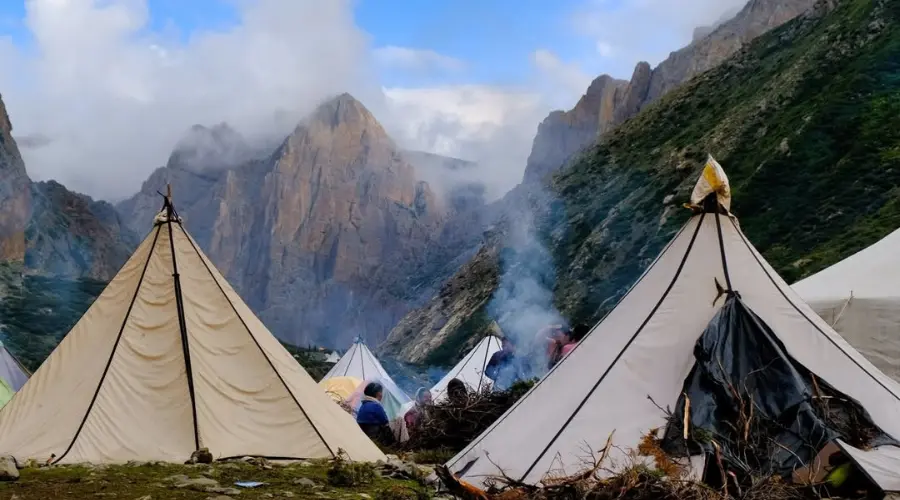
Electricity and battery recharge, water during the Upper Dolpo Trek
The electricity and battery recharge facilities are limited and sometimes unreliable in Upper Dolpo, whereas in Jomsom, they are easily available.
The majority of the teahouses and lodges usually have solar panels but are not able to consistently generate electricity. Make sure you have enough power in your devices by carrying extra batteries or a power bank with you.
Regarding water, water purification tablets or a water filter would be ideal because tap water may not be safe for consumption. Bottled water can be found at teahouses, but it is important to keep an eye on waste and to use as little plastic as possible by using refillable water bottles.
Upper Dolpo Circuit Trek
The classic trekking Upper Dolpo is an enthralling journey in the rugged terrains of the Dolpa district. A complete Upper Dolpo Circuit trek can be completed in about 24-30 days, including all the travel.
Beginning from Kathmandu, the itinerary begins with flying to Kathmandu. Then, an adventurous mountain flight takes the trekkers to Juphal, from where the actual circuit trek officially starts.
Thereafter, you get to trek for about 3 weeks through some of the awe-inspiring landscapes and mountain views through Shey Gompa, Saldang, and Dho Trap.
It captures the spiritual depth, scenic diversity, and full circle of the traditional Dolpo lifestyle. This route is ideal for those looking for seclusion and wilderness, yet immersive traditional experiences.
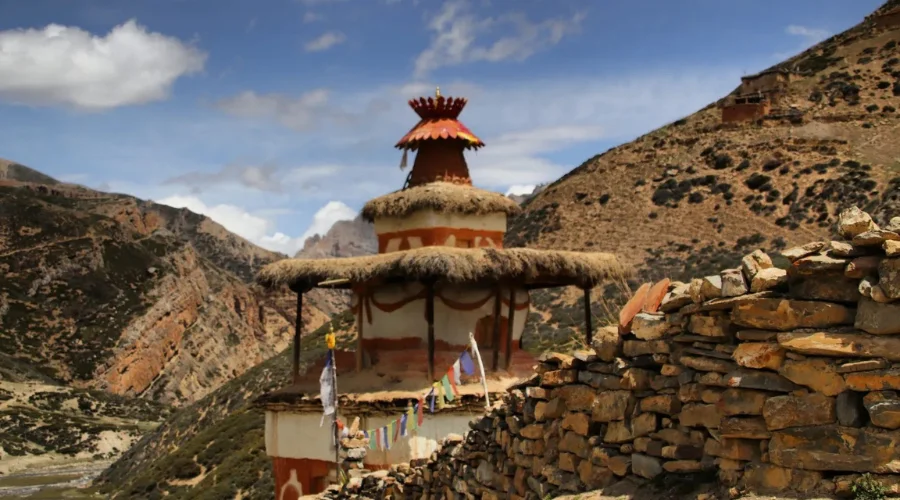
Other Dolpo Trek Route
Apart from the standard trekking route, there are other trek routes from and to Dolpo. Some of them are:
Dhorpatan Dolpo Trek
Beginning from the Dhorpatan Hunting Reserve in Rukum and entering Dolpo takes around 28-30 days. It’s perfect for those looking for a less-visited trail with rich biodiversity. It is an offbeat trek, so expect remote trails, long camping days, and outstanding natural beauty.
Lower Dolpo Trekking
If you are looking for a short and easy yet culturally rich trekking route in Dolpo, Lower Dolpo trekking is the perfect choice. This trek takes trekkers to Phoksundo Lake, Ringmo Village, and nearby Bon communities. Lower Dolpo trekking can last for 12-14 days without needing to cross challenging high passes.
Lower Dolpo Circuit Trek
Compared to the long and challenging Upper Dolpo, Lower Dolpo Circuit Trekking is an easy trekking route. This route circuits around Shey Phoksundo National Park without needing to cross restricted Upper Dolpo. During this trek, you get to visit villages like Dunai, Tarako, and Phoksundo. It can be done in just 12-14 days.
Beni To Dolpo Trek
A demanding and long journey, a journey from Beni to Dolpo takes about 30-34 days. This route connects the Annapurna Circuit Route with Dolpo trekking. It’s an expedition-level adventurous route.
Upper Dolpo to Jomsom Trek
This trek route connects Upper Dolpo with Mustang and ends in Jomsom. A 26-28 day long trek, it crosses Chharka La and Nulungsumda La passes, reaching above 5500 meters. It offers a dramatic transition from Dolpo’s stone villages to Mustang’s arid valleys.
Upper Dolpo to Upper Mustang Trek
This is one of the most culturally rich and least visited trekking routes. This trek merges the Dolpo region with the walled city of Upper Mustang. It is a 30-32 days long trek, passing through ancient salt trade routes.
Rara Lake to Upper Dolpo Trek
Combining two of the most scenic and secluded trekking destinations of Nepal, this trek lasts about 32-35 days. Starting from the exploration of tranquil, turquoise Rara Lake, the route follows towards Upper Dolpo. It is the best trekking route if you are a natural beauty admirer and looking to shoot photos and videos.
Booking Procedure
If you are looking to venture around Dolpo or planning to make an Upper Dolpo Trek blog, take photos, or make a video, you can follow a few easy steps to book the trek.
You can fill out an online form from our official website, and then we will contact you for further details and confirmation. Or you can contact us on WhatsApp, too.
Then, we will send you the trek details. You can also ask to make any adjustments to the itinerary if needed.
Once you are satisfied, you can pay the trek booking amount.
That’s it; now you can visit Nepal anytime and set out on the most exciting trek. Before starting the trek, we are going to have a brief briefing session. Then, pay the rest of the trek amount.
Documents for Booking
- A valid passport with at least 6 months’ validity
- Flight ticket details
- Two passport-sized photos
- High altitude travel insurance
- Emergency contact details
Last-minute Booking
While Upper Dolpo last-minute booking is possible, we recommend you do not do so. Sometimes, it might take longer to issue permits or arrange logistics. So, we recommend booking this or any other trek in the Himalayas at least 30 days prior to trekking.
Having said that, you can directly visit our office at Saat Ghumti, Thamel, and we will arrange all the logistics for the trip. Moreover, you will need to make full payment for the trip.
Cancellation and Postpone Policy
Trip cancellation and postponement is child’s play with Himalayan Masters. However, there are certain terms and conditions that you need to keep in mind.
Moreover, the booking amount is non-refundable. But you can use the payment for any trek at any time or transfer it to another fellow trekker.
Feedback and Review Policy
Once you have completed one of the most thrilling remote trekking in Lower and Upper Dolpo Trek, do not forget to leave feedback and review. Your feedback is much appreciated, as it helps us overcome our shortcomings and improve your trekking experiences.
Final words,
Well, we don’t need to say that the Upper Dolpo trek is a once-in-a-lifetime kinda journey that has been reserved only for the bravest souls. So, get ready for this utmost form of adventure with Himalayan masters.
FAQs
How hard is the Upper Dolpo Trek?
A month-long journey on land with no houses, no internet, and no electricity is not a joke. The experts have marked the Inner Dolpo trek difficulty as “Challenging.” And this is among Nepal’s hardest and longest trekking trails.
What kind of accommodation on Upper Dolpo is available?
Is the Upper Dolpo trek worth it?
Is Dolpo and Dolpa same?
Can you trek solo in the Upper Dolpo region?
What is the cost of the Nepalgunj to Juphal flight price?
Can I trek Dolpo without a permit?
Is a helicopter ride to Upper Dolpo possible?
Can I travel from Kathmandu to Dolpo by bus?
What is the introduction of Bon religion from Dolpo?
What is the mountain seen from Upper Dolpo trekking?
Can we see a snow leopard?
How long is the upper Dolpo Trek?
How much does the Upper Dolpo trek cost for Nepali?
What is Shey Festival Dolpo?
Speak to an Expert





Sandip Dhungana
Nepal 🇳🇵
Whatsapp: +977-9823636377
Speak to an Expert





Sandip Dhungana
Nepal 🇳🇵
Whatsapp: +977-9823636377


